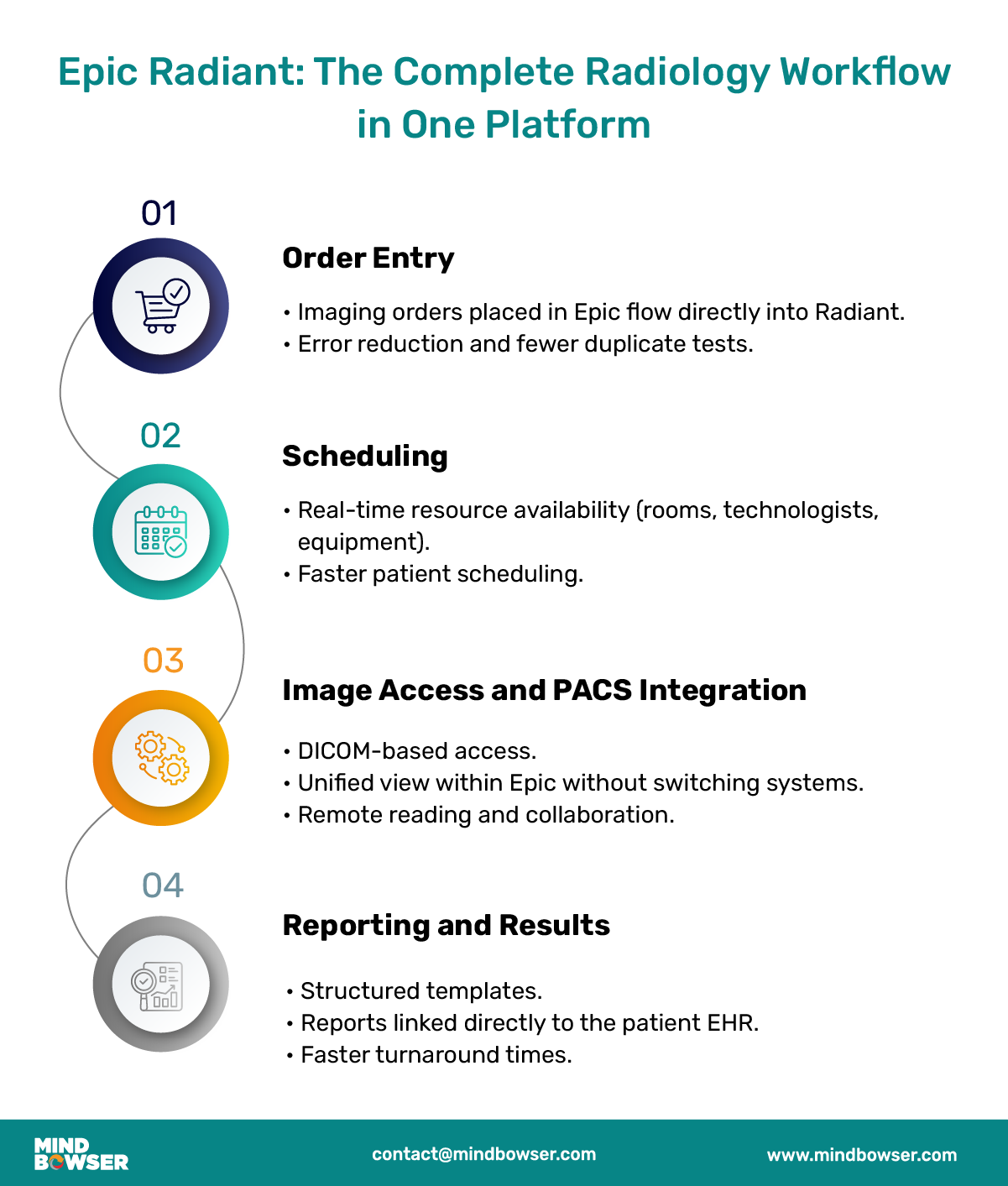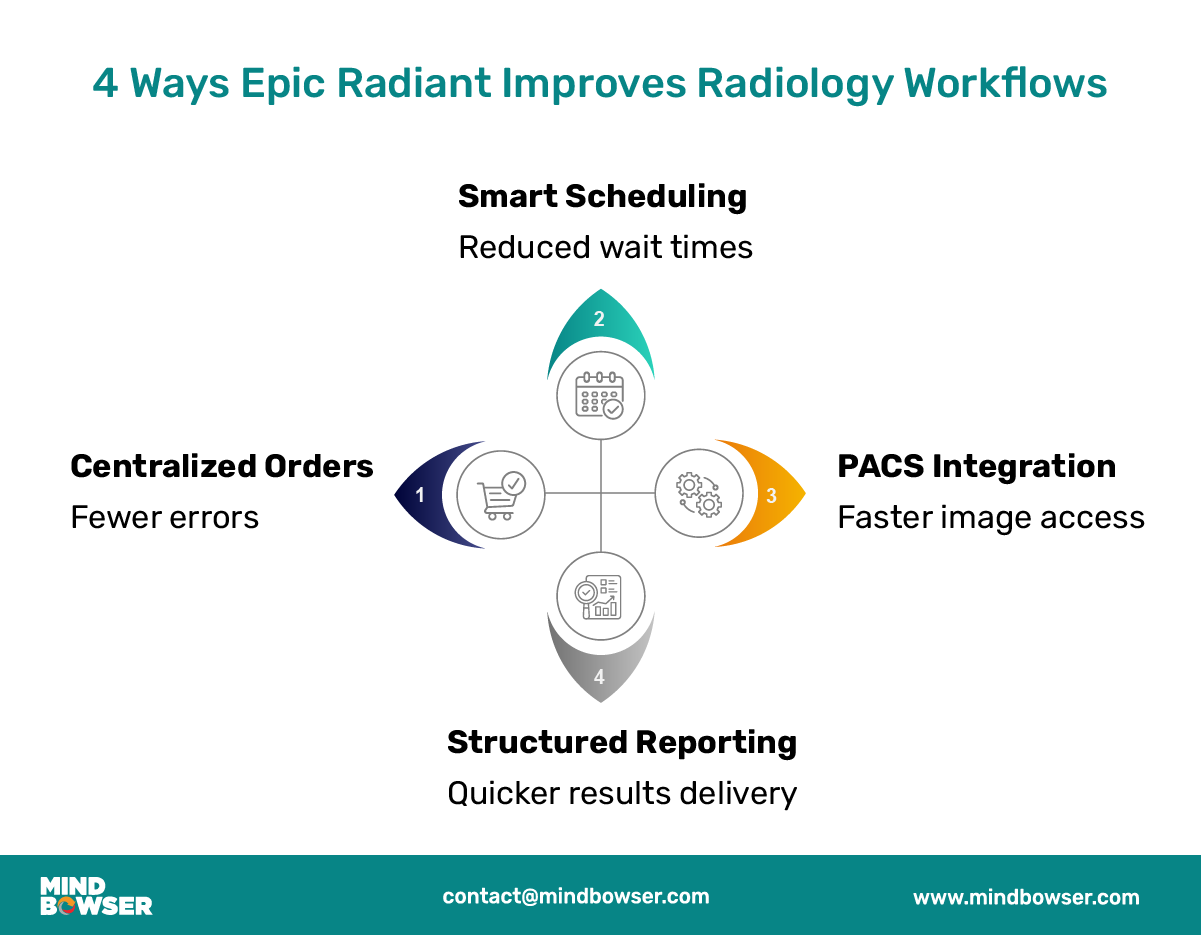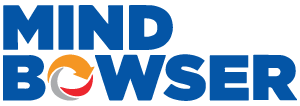Radiology sits at the center of modern care delivery, touching everything from emergency medicine to oncology. Yet inefficiencies in scheduling, image access, and reporting often create costly delays. Diagnostic imaging represented nearly 40% of all imaging performed per patient in 2021, making streamlined workflows critical for both providers and patients.
Epic Radiant is Epic’s dedicated radiology module, built to support imaging departments in hospitals and clinics. It connects ordering physicians, radiologists, and technologists through a shared platform, eliminating duplicate steps and ensuring information flows consistently. The result is faster diagnosis, smoother coordination of care, and more reliable reporting for providers working under increasing time and cost pressures.
Epic Radiant is the radiology module within the Epic EHR ecosystem. It was designed to simplify the management of orders, scheduling, image review, and reporting in imaging departments. Instead of relying on separate systems for each task, Radiant brings these functions into one integrated platform that works in sync with the rest of Epic.
At its core, Radiant manages the full imaging workflow:
For radiologists, Radiant centralizes images and patient data, cutting down the time spent searching across disconnected systems. For technologists, it provides clear worklists and visibility into scheduling. For referring physicians, it ensures timely results are delivered directly into the patient’s record, supporting faster clinical decisions.
By embedding radiology directly into the Epic workflow, Radiant reduces friction across the care continuum and strengthens collaboration among care teams.
Radiology plays a vital role in patient care; however, many imaging departments still face persistent challenges that slow down operations and impact outcomes. Providers often encounter issues stemming from disconnected systems, inefficient processes, and communication gaps. Four of the most common challenges include:
When radiology departments operate in silos, communication with referring physicians and other care teams often suffers. Missing information, unclear requisitions, or delayed updates can lead to confusion, additional phone calls, and unnecessary back-and-forth, all of which slow down patient care.
Imaging services are in high demand, but many facilities still rely on manual scheduling processes or outdated tools. This creates bottlenecks, resulting in patients waiting longer than necessary for scans. Delays not only frustrate patients but also affect downstream clinical decisions and treatment plans.
Paper forms or poorly integrated systems increase the risk of transcription errors and incomplete information. A single mistake in entering patient demographics, exam type, or clinical indication can result in wasted time, repeated imaging, or even incorrect billing.
Many radiology teams still log in to separate systems to view images, manage reports, and update patient records. This constant switching between platforms takes time and increases the chance of oversight. Without seamless integration, radiologists spend more time navigating systems than interpreting studies.
These challenges collectively result in longer turnaround times, increased operational costs, and lower satisfaction for both patients and providers. Addressing them requires a system that can unify workflows, improve accuracy, and give teams the tools to work more efficiently together.
Epic Radiant was designed to tackle the inefficiencies that imaging departments face every day. By unifying radiology within the Epic ecosystem, it eliminates duplicate steps, improves visibility, and speeds up the flow of information across teams. Several features stand out in how it reshapes radiology operations:
Radiant captures imaging orders directly within the patient’s chart, ensuring accuracy from the start. Instead of re-entering information across multiple systems, providers see a single order that flows from the physician to the technologist and ultimately to the radiologist. This reduces duplicate testing, minimizes data entry errors, and ensures the right study is performed for the right patient.
With Radiant, scheduling staff can see real-time availability of rooms, machines, and technologists. The system optimizes appointment slots, allowing patients to be seen sooner and ensuring resources are fully utilized. For patients, this means shorter wait times. For providers, it translates into higher throughput and fewer scheduling conflicts.
Radiologists often face the challenge of balancing speed with accuracy. Radiant provides structured templates that standardize reporting while allowing customization when needed. Reports are linked directly to the patient’s EHR and shared instantly with referring providers. The system can also connect with AI-driven tools for preliminary reads, helping radiologists focus on complex cases without delaying results.
By combining order entry, scheduling, image access, and reporting in one environment, Epic Radiant streamlines the entire imaging journey. Each step flows into the next without the friction of switching systems, which not only improves efficiency but also strengthens the accuracy and reliability of radiology services.
One of the biggest strengths of Epic Radiant is how it integrates with Picture Archiving and Communication Systems (PACS). Radiologists rely on PACS for image storage and retrieval, but when PACS operates as a standalone system, it often slows down workflow. Radiant closes this gap by connecting directly with PACS to create a unified imaging environment.
Radiant allows clinicians to pull up images directly from the EHR without opening a separate system. This integration reduces delays and provides radiologists with immediate access to studies alongside patient records, supporting faster clinical decision-making.
Switching between multiple platforms wastes valuable time and increases the chance of oversight. With PACS data linked into Radiant, radiologists can review images, dictate reports, and finalize results within the same environment where patient information is stored.
Radiant is built to work with DICOM, the global standard for medical imaging. This ensures that images from different scanners and vendors can be accessed without compatibility issues. For hospitals with multiple modalities and vendors, standardization is crucial for maintaining consistency and efficiency.
By integrating PACS directly into the EHR, Radiant also supports remote access. Radiologists can review studies and collaborate with colleagues across sites without extra steps. This is particularly valuable for multi-location practices and health systems looking to centralize radiology services.
Through PACS integration, Epic Radiant transforms imaging from a fragmented process into a single connected workflow. Radiologists gain back time, referring providers get results faster, and patients benefit from reduced delays in care.

Epic Radiant is powerful on its own, but its full value comes from how it integrates with other Epic modules. By connecting radiology workflows with laboratory data, cardiology imaging, and broader clinical systems, Radiant helps providers see the complete patient picture. Two integrations are especially impactful:
Radiology and laboratory testing often go hand in hand, especially in complex cases like oncology or infectious disease. Epic Radiant integrates smoothly with Beaker to bring imaging and lab data into the same patient record.
Cardiology imaging requires high levels of coordination, and patients often undergo both radiology and cardiology studies. Radiant’s integration with Cupid ensures that cardiovascular imaging data is connected to the broader radiology record.
Through its integration with Beaker and Cupid, Epic Radiant ensures that radiology is not an isolated process. Instead, it becomes an integral part of the clinical workflow, enabling providers to make more informed decisions across disciplines.
Related read: 5 Ways Custom EHR Development Bridges the Gaps in Epic Cupid
Mindbowser is part of the Epic Vendor Program, which ensures that technology partners meet Epic’s technical, security, and compliance standards. This gives providers confidence that integrations built with our team align with Epic’s framework and support long-term reliability.
Our expertise goes beyond simple module integration. We help hospitals and health systems build custom EHR platforms with Epic integration capabilities, providing them with the flexibility to extend functionality while maintaining fully connected workflows to Radiant. This approach is particularly valuable for organizations that need to tailor their imaging workflows, billing processes, or reporting structures without stepping outside Epic’s ecosystem.
To achieve this, our team leverages modern healthcare interoperability standards:
We also bring deep experience working with provider organizations on module optimization, workflow customization, and interoperability design. This includes aligning Radiant workflows with operational requirements such as staff scheduling, clinical documentation, and compliance mandates.
Compliance is at the center of our builds. By maintaining HIPAA and SOC 2 standards throughout the development lifecycle, we ensure that radiology data is secure, private, and audit-ready. Our work enables providers to enhance the functionality of Epic Radiant while maintaining compliance with the stringent regulations governing healthcare IT.
Through our role in the Epic Vendor Program, Mindbowser provides healthcare organizations with a trusted partner to customize, integrate, and extend Radiant in ways that directly improve efficiency and care delivery.
Epic Radiant offers a direct path to more efficient, accurate, and patient-centered imaging services. By unifying radiology workflows within the Epic ecosystem, providers achieve measurable improvements in both clinical and operational performance.
In combination, these benefits position Epic Radiant as more than just a radiology information system. It becomes a tool that strengthens collaboration, supports clinical accuracy, and creates value for patients, providers, and payers alike.

Hospitals and health systems that adopt Epic Radiant often see measurable improvements in how radiology supports patient care and operations. Two examples highlight its impact in real-world settings.
These examples demonstrate how Radiant addresses real-world provider challenges, including turnaround delays and fragmented reporting. By bringing radiology into the larger Epic ecosystem, hospitals and practices gain consistency, speed, and collaboration that directly improve both patient care and operational performance.
While Epic Radiant is built to work seamlessly within the Epic ecosystem, most hospitals and health systems need their radiology workflows to connect with other technologies as well. This is especially true for organizations that rely on multiple vendors for imaging, data exchange, and care coordination. Radiant supports this need through its ability to integrate with external systems and advanced interoperability frameworks.
Through these integrations, Epic Radiant extends its value beyond the Epic platform. Hospitals and radiology groups can connect imaging workflows to a larger digital health ecosystem, making data more accessible and care more coordinated.
Epic Radiant has become a vital tool for hospitals and radiology groups seeking to enhance efficiency, accuracy, and care coordination. For organizations evaluating their imaging workflows, several lessons stand out:
For hospitals and practices, the takeaway is clear: Radiant is not just another imaging tool. It is a strategic investment in improving the speed, accuracy, and reliability of radiology while ensuring integration with the broader EHR environment.
Epic Radiant is Epic’s radiology module that manages imaging orders, scheduling, image access, and reporting within the Epic EHR. It helps radiology teams work more efficiently and ensures results are delivered quickly to referring providers.
Epic Radiant connects directly with PACS, allowing radiologists to view images within the EHR without switching systems. It supports DICOM standards, enabling compatibility across various imaging modalities and vendors, while also facilitating easier remote reading and collaboration.
Yes. Epic Radiant integrates with modules like Epic Beaker for laboratory workflows and Epic Cupid for cardiology imaging. This creates a unified clinical record that combines radiology, laboratory, and cardiology data, thereby improving diagnostic accuracy and facilitating multidisciplinary collaboration.
Providers using Epic Radiant often see faster turnaround times, fewer redundant tests, improved reporting accuracy, and better coordination between departments. These benefits translate into cost savings for hospitals and a smoother care experience for patients.
Mindbowser is part of the Epic Vendor Program and specializes in building custom EHR platforms with Epic integration capabilities. Our team helps providers optimize Radiant workflows, develop SMART on FHIR apps, and ensure compliance with HIPAA, HL7, and SOC 2 standards.

We worked with Mindbowser on a design sprint, and their team did an awesome job. They really helped us shape the look and feel of our web app and gave us a clean, thoughtful design that our build team could...


The team at Mindbowser was highly professional, patient, and collaborative throughout our engagement. They struck the right balance between offering guidance and taking direction, which made the development process smooth. Although our project wasn’t related to healthcare, we clearly benefited...

Founder, Texas Ranch Security

Mindbowser played a crucial role in helping us bring everything together into a unified, cohesive product. Their commitment to industry-standard coding practices made an enormous difference, allowing developers to seamlessly transition in and out of the project without any confusion....

CEO, MarketsAI

I'm thrilled to be partnering with Mindbowser on our journey with TravelRite. The collaboration has been exceptional, and I’m truly grateful for the dedication and expertise the team has brought to the development process. Their commitment to our mission is...

Founder & CEO, TravelRite

The Mindbowser team's professionalism consistently impressed me. Their commitment to quality shone through in every aspect of the project. They truly went the extra mile, ensuring they understood our needs perfectly and were always willing to invest the time to...

CTO, New Day Therapeutics

I collaborated with Mindbowser for several years on a complex SaaS platform project. They took over a partially completed project and successfully transformed it into a fully functional and robust platform. Throughout the entire process, the quality of their work...

President, E.B. Carlson

Mindbowser and team are professional, talented and very responsive. They got us through a challenging situation with our IOT product successfully. They will be our go to dev team going forward.

Founder, Cascada

Amazing team to work with. Very responsive and very skilled in both front and backend engineering. Looking forward to our next project together.

Co-Founder, Emerge

The team is great to work with. Very professional, on task, and efficient.

Founder, PeriopMD

I can not express enough how pleased we are with the whole team. From the first call and meeting, they took our vision and ran with it. Communication was easy and everyone was flexible to our schedule. I’m excited to...

Founder, Seeke

We had very close go live timeline and Mindbowser team got us live a month before.

CEO, BuyNow WorldWide

Mindbowser brought in a team of skilled developers who were easy to work with and deeply committed to the project. If you're looking for reliable, high-quality development support, I’d absolutely recommend them.

Founder, Teach Reach

Mindbowser built both iOS and Android apps for Mindworks, that have stood the test of time. 5 years later they still function quite beautifully. Their team always met their objectives and I'm very happy with the end result. Thank you!

Founder, Mindworks

Mindbowser has delivered a much better quality product than our previous tech vendors. Our product is stable and passed Well Architected Framework Review from AWS.

CEO, PurpleAnt

I am happy to share that we got USD 10k in cloud credits courtesy of our friends at Mindbowser. Thank you Pravin and Ayush, this means a lot to us.

CTO, Shortlist

Mindbowser is one of the reasons that our app is successful. These guys have been a great team.

Founder & CEO, MangoMirror

Kudos for all your hard work and diligence on the Telehealth platform project. You made it possible.

CEO, ThriveHealth

Mindbowser helped us build an awesome iOS app to bring balance to people’s lives.

CEO, SMILINGMIND

They were a very responsive team! Extremely easy to communicate and work with!

Founder & CEO, TotTech

We’ve had very little-to-no hiccups at all—it’s been a really pleasurable experience.

Co-Founder, TEAM8s

Mindbowser was very helpful with explaining the development process and started quickly on the project.

Executive Director of Product Development, Innovation Lab

The greatest benefit we got from Mindbowser is the expertise. Their team has developed apps in all different industries with all types of social proofs.

Co-Founder, Vesica

Mindbowser is professional, efficient and thorough.

Consultant, XPRIZE

Very committed, they create beautiful apps and are very benevolent. They have brilliant Ideas.

Founder, S.T.A.R.S of Wellness

Mindbowser was great; they listened to us a lot and helped us hone in on the actual idea of the app. They had put together fantastic wireframes for us.

Co-Founder, Flat Earth

Mindbowser was incredibly responsive and understood exactly what I needed. They matched me with the perfect team member who not only grasped my vision but executed it flawlessly. The entire experience felt collaborative, efficient, and truly aligned with my goals.

Founder, Child Life On Call

The team from Mindbowser stayed on task, asked the right questions, and completed the required tasks in a timely fashion! Strong work team!

CEO, SDOH2Health LLC

Mindbowser was easy to work with and hit the ground running, immediately feeling like part of our team.

CEO, Stealth Startup

Mindbowser was an excellent partner in developing my fitness app. They were patient, attentive, & understood my business needs. The end product exceeded my expectations. Thrilled to share it globally.

Owner, Phalanx

Mindbowser's expertise in tech, process & mobile development made them our choice for our app. The team was dedicated to the process & delivered high-quality features on time. They also gave valuable industry advice. Highly recommend them for app development...

Co-Founder, Fox&Fork
